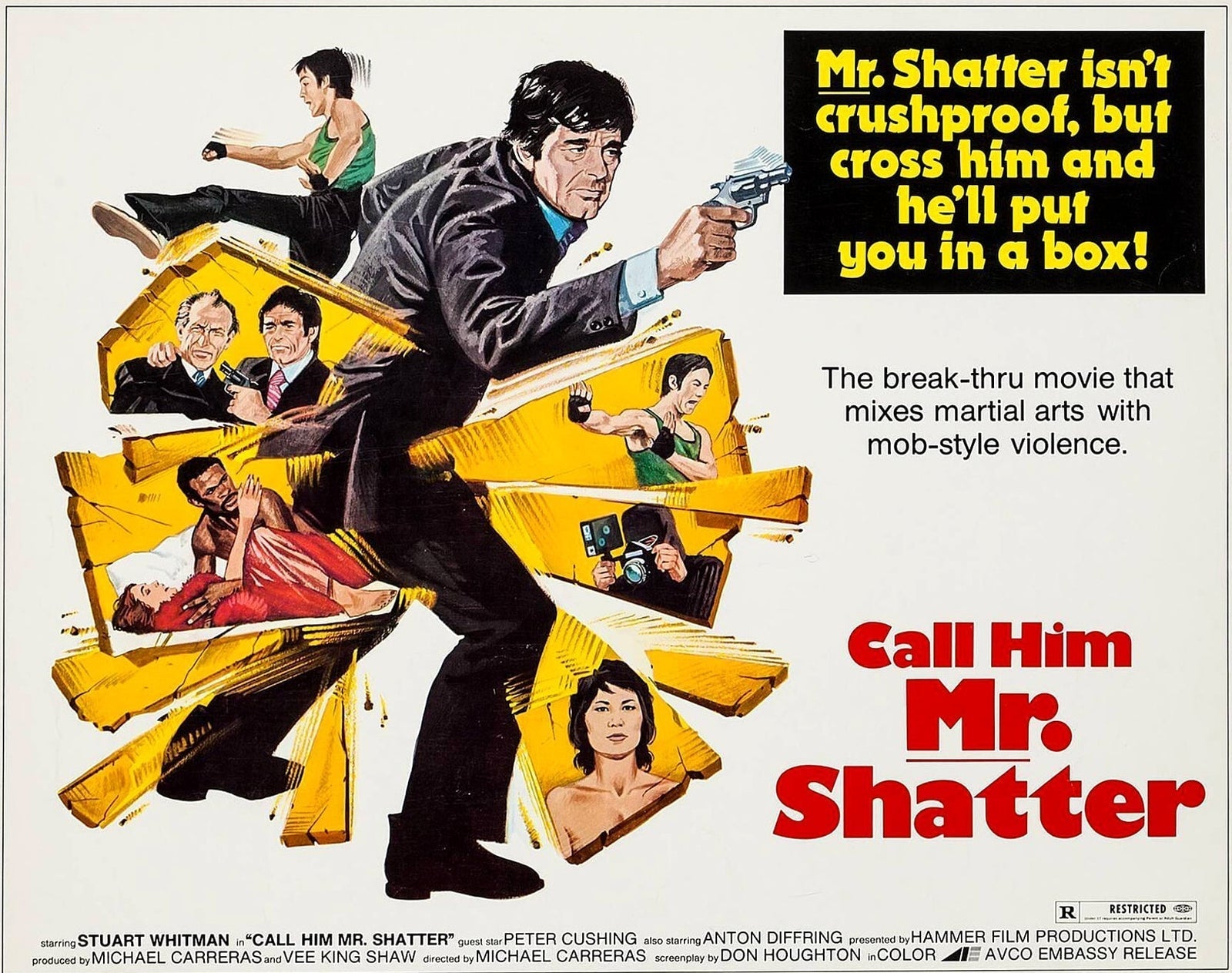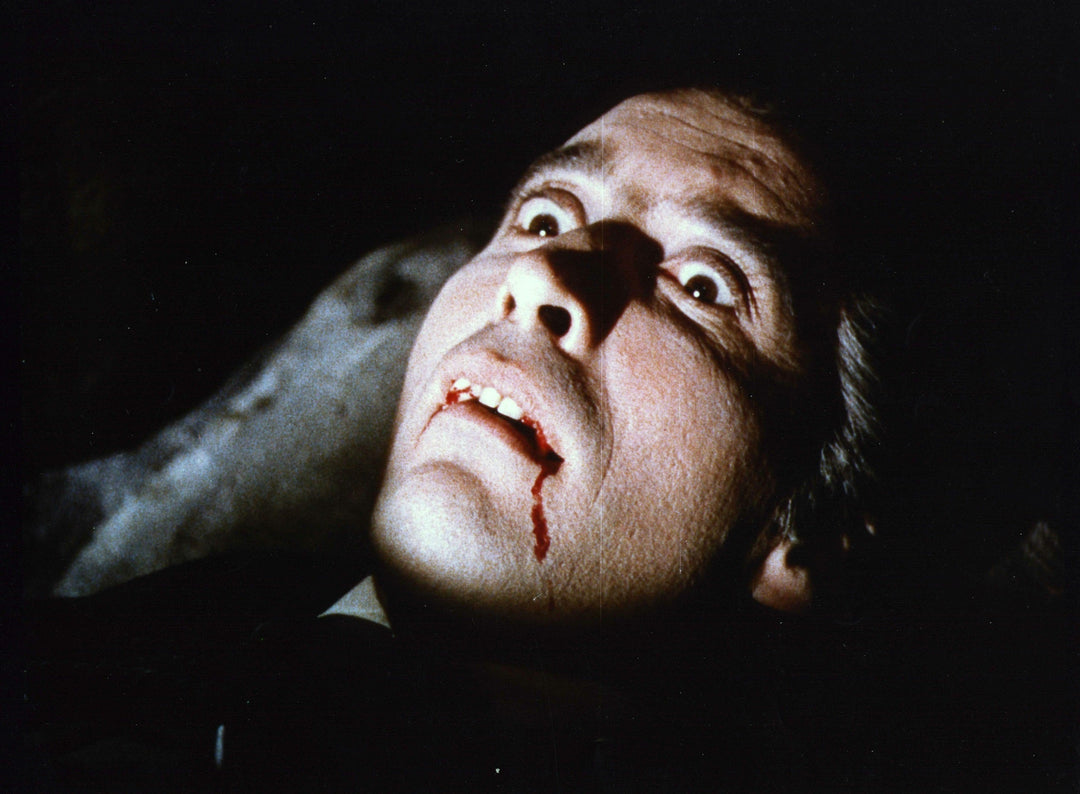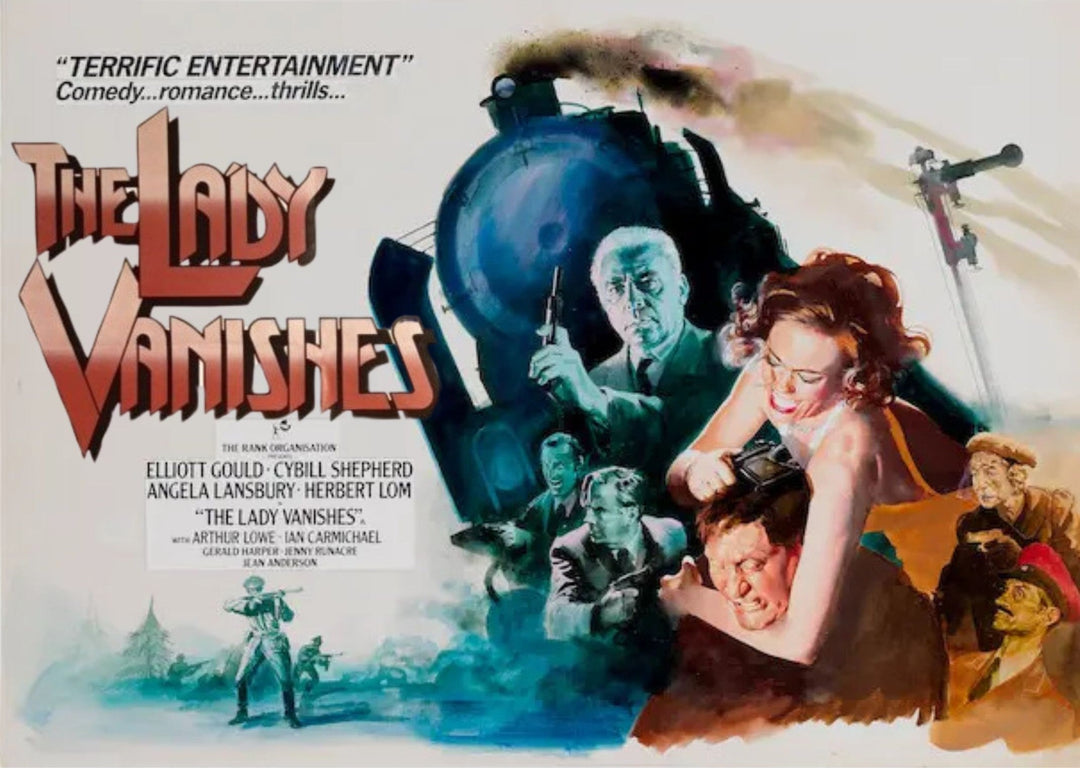Shatter is back!

We’re delighted to confirm that the next title to be restored and released by Hammer Films will be Shatter (1974), an action thriller starring Stuart Whitman, Ti Lung, Lily Li and Peter Cushing. Expect international intrigue, mystery and martial arts aplenty!
We spoke to Hammer’s current Cryptkeeper, Steve Rogers, to find out more about the movie and the extras included with this imminent release.
Hammer News: Let’s start with the basics! For anyone who has yet to meet Mr Shatter, what’s the film about?
Steve Rogers: It's about a freelance hitman who takes a CIA contract for a high profile kill. He does the job, flies to Hong Kong to get his money and finds out it wasn't the CIA that hired him after all – it was the mob. Disavowed by the CIA and pursued by both criminals and the police, Shatter hires a local martial arts expert to keep him alive and help him get what he's owed. Mayhem ensues.

The film features Peter Cushing in his last movie for Hammer.
HN: Shatter is arguably one of those movies where the plotline isn’t as important as its visual dynamics, music, fight sequences and cinematic ethos. Its overall feel. Would that be fair to say? And in terms of those elements, what does Shatter give us?
SR: Shatter is certainly style, but there's substance also. If anything the plot is over-complex, not the opposite, but it is certainly a very stylish and stylised film – as one would expect from an East-meets-West mashup shot the year that Enter the Dragon hit the streets.
HN: Hammer have recently been restoring and releasing films that feel very different in tone and theme. What’s the thinking behind the choice of titles?
SR: Hammer is horror – there's no denying that. But during peak production in the '50s and '60s Hammer was also a jobbing film studio and, as well as the gothics, they also made war films, comedies, crimers, psychoterrors, cavegirl pics, etc. The legacy of Hammer is all of that and more – and that's something we're keen to celebrate in Hammer's 90th year, that sheer diversity of output.
For those who only love the horrors they won't be short-changed, I promise, but for those who are interested in the full range of Hammer's output, or even film collectors in general who aren't particularly Hammer-orientated, there will be much to revisit and enjoy over the coming months and years.
HN: With that in mind, what makes Shatter ripe for revival at this point?
SR: Everything. It's Hammer, it's kung fu, it's a 1970s crime caper (the best decade for such things, as everyone knows), it's never been available on DVD or Blu-ray in the UK, the 4K restoration is complete and uncut (it was censored on cinema release for violence) and it's got a comprehensive package of additional material that covers all these aspects of the film and more.

Call him Mr. Whitman…
HN: I’d like to ask you about three of the film’s stars. First up, Shatter himself – Stuart Whitman. In 1958 Hedda Hopper predicted he could be the ‘new Clark Gable’ and his role in The Mark (1961) earned him an Oscar nomination for Best Actor in a Leading Role. But he never quite broke through to the heights of acting royalty. What does he bring to this movie?
SR: By the end of 1973, Whitman was world-weary and a bit punchy – and that's exactly what he brings to this role: himself. He is exactly the sort of personality you can see getting into this sort of scrape and ending up kicking his way out of it. It's really not a performance and it's hard to see anyone else doing it better.

A lobby card for the German market puts Ti Lung front and centre.
HN: One of the film’s other stars is an icon of martial arts movies - the legendary Ti Lung. Tell us a little about what makes him so special.
SR: At this point Ti Lung was one of several rising stars at the Shaw Brothers film factory, but you can see in his performance here that he was destined for greater things. When Bruce Lee died unexpectedly in 1973 everyone was looking for the next Bruce Lee (and there were many clones and knock-offs!). Ti Lung wasn't one of the clones, he did his own thing but he had Lee's gravitas – something a lot of his contemporaries were missing. The last ten or fifteen minutes of the film – the fight at the fishing village, the boat trip to Macao, the rumpus in the hotel suite and the final scene on the wharf show you that this guy was damned good at both the action *and* the quiet stuff.

The film was released as Call Him Mr. Shatter in the US.
HN: The cast also includes Peter Cushing in last Hammer feature. Does he go out on high?
SR: When we were recording the commentary for the US version of the film with Heidi Honeycutt and Toby Roan, they both said that there's no such thing as a bad Peter Cushing performance – he finds a way to own every role he takes, big or small. I can't see anyone ever arguing with that assessment and it's certainly true here.
He only appears in a few scenes, filmed just before Christmas 1973 once he'd finished filming Legend of the 7 Golden Vampires, but his presence is felt throughout. He adds his little character touches (he likes his boiled sweets in this one) and he gives an absolute masterclass in info-dumping, coming across as actually quite sinister in places. It may be a small role and it may have been his Hammer film swansong, but he nailed it again. No arguing about that.

Extensive location filming in Hong Kong captured what is now a bygone era.
HN: There’s a lot of quietly fascinating location work in Shatter. It means watching the film today feels like we’re taking a peek into the past, and we’re certainly a long way from Bray! Do you think that’s part of the movie’s charm? And was it shot entirely in Hong Kong?
SR: Not only was it all shot in Hong Kong, it was almost entirely shot on location. It seems that the Shaw studios were only used for a small amount of filming and everything else was done on the streets – the very thing that gives the film such character now. When Shatter was filmed in December 1973/January 1974, its grim-and-gritty view of a smog bound Hong Kong was labelled as "dreary" and "like a slum" but, fifty years later, it is precisely that thing that makes the film seem so stylish.
In those five decades Hong Kong has changed almost totally, so to see empty shorelines, waste land, grubby streets and Kai Tak airport is to take a smog-and-nicotine-tinged time trip back to the early 1970s, when men were men and people shot at hotels with grenade launchers.
HN: The screenplay is by Don Houghton. He wrote some terrific stuff for Hammer and his TV output (including the 1970 Doctor Who classic, Inferno, and Sapphire and Steel’s atmospheric Assignment Five) often seems to push the boundaries of the series he was scripting for. Would you say he’s an underrated writer?
SR: I'd certainly say that he's not as well recognised as he deserves to be. For a couple of years in the early 1970s he was basically Hammer's in-house "script guy", but the Shaw Brothers co-productions brought any simmering issues to a head and he walked off Shatter (he was writer and producer) before filming started due to creative differences with the director.
HN: Wait a second! Shatter was directed by one of Hammer’s head honchos – Michael Carreras! What goes on here?
SR: Well, Carreras was an accomplished director and writer, as well as a producer – and company owner of Hammer – by that point. He was not the first director, however – that was cult American director Monte Hellman. Hellman clashed with Houghton and started to rewrite the script two weeks before principal photography started. By the second week of filming they were behind, by the third week even more so – by week four Hellman was gone and Carreras had to step in and finish the film. It was a stressful, contentious production and this is covered in great detail in the additional material in the set.

Lily Li, who enjoyed a career spanning over 50 years, stars as Mai-Mee in Shatter.
HN: Talking of which… Aside from the film itself, what can we look forward to with this release?
SR: We've got two iterations of the film – British and American – with a great new commentary on each. We've also included a remastered version of the laserdisc commentary that features Monte Hellman and Stuart Whitman. There are several new programmes on the disc that cover Hammer in the 1970s (and the Shaws co-productions in particular), 1970s crime films and martial arts cinema, composer David Lindup (by his son Mike) and an archive interview with Renee Glynne.
The 120-page book covers the making of the film, "East Meets West" productions, Shatter's influences and a comparison of the draft script against the shooting script and the film itself – plus facsimiles of production paperwork and the original story treatment. It doesn't matter whether you like Hammer, martial arts or 1970s thrillers – all angles are covered on this one.
Many thanks to Steve Rogers for the information and update. We’ll be bringing you more news about Shatter, including the release schedule, soon. In the meantime, you can stay bang up-to-date with all things Hammer by signing up to the newsletter now!


